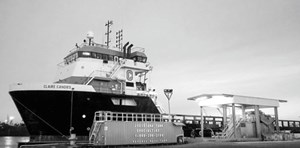Automatic tank cleaning system helping to weather price slide
Since offshore rig tanks must be cleaned after every displacement to avoid any fluid cross-contamination, RCS Tank Cleaning Solutions has a birds-eye view of the level of drilling activity in the Gulf of Mexico. What it sees—especially in the near-term—is not all that encouraging.
“Things have slowed down. Customers are driving down costs and pulling back on some of their projects,” said Paul Hebert, owner of RCS, a 10-year-old company that developed a patent for an automatic tank cleaning technology to cut down confined space entry requirements. “We’re feeling the effects of it and it will be a challenge, but fortunately we’re very stable so we think we’ll survive it quite nicely.”
For now, customized versions of its automatic closed loop tank cleaning systems are onboard nine rigs, with two nearly identical units permanently installed at the RCS Port Fourchon base to clean the tanks of incoming supply vessels. Based in Lafayette, La., the privately held-company operates from a 15-acre site in Port Fourchon, with 1,100-linear ft of bulkhead, and 80 rotating employees.
Hebert said its automated tank cleaning systems are pre-programmed to meet specific tank dimensions and geometric configurations. During the shore-based cleaning operation, a wash water pill, comprising water, surfactants and other chemicals, tailored to the specific characteristics of the fluid to be cleaned, is pumped into the dirty tanks on the vessel. There, hydraulic jets perform the cleaning operation automatically at pressures of 200 psi or greater with the recovered material pumped onshore. The sludge is stripped out and the now-cleaned wash water is recycled and reused in another cleaning sweep.
A similar, on-the-fly cleaning process is carried out on offshore rigs, with the only exception being that, unlike the more standardized onshore cleaning system, each rig-based configuration is customized to meet individual rig dimensions. “For the rigs, we first do a survey to determine the tank dimensions and other requirements and develop a rig-specific design. So, we engineer it, we build it, we install it and we run it,” he said. “We developed this technology, because we realized there had to be a better way of cleaning tanks.”
Once the solids entrained in drilling fluids dry and harden, concrete-like residue is left on the interior walls of the tanks, while as much as 3 ft of hardened sludge can build up on the floor. The conventional method for removing this accumulation requires personnel using pressure washers, scrub brushes, scrapers, pick axes and shovels to dislodge the deposited material. Not only can this process require up to 96 man-hr, according to some operators, but requires extremely hazardous, confined, space entry. There, workers face exposure to drilling fluid chemicals and wash fluids, potentially explosive gases, low oxygen levels and the inherent risks of using high-pressure hoses and washers on slippery, and uneven, floors. In addition, with manual cleaning, none of the wash water can be reused, generating tremendous volumes of waste that must be transported to disposal sites.
Offshore, Hebert said the automatic system has eliminated the need for confined space entry, long considered among the most hazardous and unhealthy activities in the oil field. In addition, he said the system has cut—by at least half—the time required to clean a tank, which offshore means three, or four, times during the course of a well, as operators must frequently displace from water to invert emulsion drilling fluids and, finally, completion brines. Any residue from the previous system can create havoc with fluid properties downhole, and negatively affect the drilling operation. “Along with the obvious HSE benefits, it’s more efficient, as the folks on the rigs tell us we are able to clean a tank in less than half the time of manual cleaning,” Hebert said.
Further, a typical manual tank cleaning operation requires roughly 1,200 bbl of wash water that must be discarded after each operation.
As for the onshore setup, he said the technology has reduced confined space entry in supply vessel fluid tanks from 85% to 90%. The Port Fourchon shore base also includes a simulator for training in cleaning both flat and slope-tank geometric shapes, he said. ![]()
- Coiled tubing drilling’s role in the energy transition (March 2024)
- Advancing offshore decarbonization through electrification of FPSOs (March 2024)
- Subsea technology- Corrosion monitoring: From failure to success (February 2024)
- Digital tool kit enhances real-time decision-making to improve drilling efficiency and performance (February 2024)
- E&P outside the U.S. maintains a disciplined pace (February 2024)
- U.S. operators reduce activity as crude prices plunge (February 2024)
- Applying ultra-deep LWD resistivity technology successfully in a SAGD operation (May 2019)
- Adoption of wireless intelligent completions advances (May 2019)
- Majors double down as takeaway crunch eases (April 2019)
- What’s new in well logging and formation evaluation (April 2019)
- Qualification of a 20,000-psi subsea BOP: A collaborative approach (February 2019)
- ConocoPhillips’ Greg Leveille sees rapid trajectory of technical advancement continuing (February 2019)



